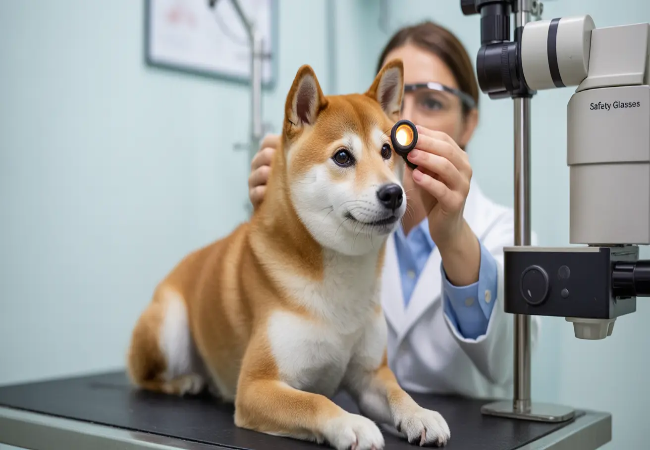Veterinary Guide to Canine Iris Bombe 2025 🩺🐶

In this article
Veterinary Guide to Canine Iris Bomb 2025 🩺🐶
By Dr. Duncan Houston BVSc
🧬 What Is Iris Bombe?
Iris bombe, also known as complete posterior synechiae, occurs when the iris adheres completely to the lens capsule, blocking aqueous humor flow from the posterior to anterior chamber. This causes pressure build-up, characteristic iris bowing (“bombé”), and often precipitates acute angle-closure glaucoma.
👥 Who Can Be Affected?
While no specific breed, age, or sex predisposition is noted, iris bombe most often occurs as a complication of:
- Chronic anterior uveitis or iridocyclitis.
- Trauma, corneal ulcers, ocular surgery, hyphema, or foreign body injuries.
⚠️ Clinical Signs
- Squinting, ocular pain, and redness (blepharospasm, epiphora).
- Corneal ulcers or lesions and lens opacity (early cataract signs).
- Variable iris color, misshapen pupil, poor reaction to light.
- Elevated intraocular pressure (IOP) and signs of glaucoma—cloudy cornea, vision loss.
- Uveitis: flare, miosis, aqueous cloudy, possible hyphema.
🔍 Diagnostic Approach
- History & exam: Note previous eye inflammation/injury, ocular discomfort.
- Ophthalmic exam: Slit lamp/biomicroscopy to detect iris-lens adhesions and anterior chamber depth.
- Tonometry: Measure IOP—values above 25 mmHg suggest glaucoma; >50 mmHg indicates acute closure risk.
- Dye testing: Fluorescein helps detect corneal ulcers contributing to uveitis.
- Gonioscopy: Evaluate angle blockage and trabecular meshwork
- Ultrasound: Useful if media opacity prevents direct visualization.
⚙️ Treatment Strategies
1. Medical Management
- Anti-inflammatories: Topical corticosteroids (e.g., prednisolone acetate), systemic NSAIDs, or oral corticosteroids to resolve uveitis and prevent further synechiae.
- IOP-lowering agents: Osmotic diuretics (mannitol), topical beta-blockers, carbonic anhydrase inhibitors, prostaglandin analogues—reduce aqueous production/increase outflow.
- Miotics: Pilocarpine to open the angle and lessen iris bombé—used cautiously if inflammation is controlled.
2. Surgical Management
- Laser peripheral iridotomy (LPI): Creates channels in iris to relieve pressure, restore flow and break adhesions.
- Surgical iridectomy: In refractory cases, partial surgical removal of the iris.
- Glaucoma surgery: Placement of drainage implants (e.g., Baerveldt, Ahmed), and lens removal if cataract complicates flow.
3. Addressing Underlying Cause
- Treat corneal ulcers, infections, or trauma contributing to uveitis.
- Manage systemic conditions (e.g., tick-borne, autoimmune) triggering uveitis.
📈 Prognosis & Monitoring
- Prognosis varies: excellent with prompt treatment of inflammation, moderate if glaucoma detected early, poor if irreversible optic damage occurred.
- Follow-up schedule: IOP checks 24 hrs after treatment, then weekly; assess visual function, intraocular inflammation regularly.
- Monitor for complications: cataract formation, persistent synechiae, chronic glaucoma.
🏡 Home Care & Preventive Measures
- Administer all prescribed meds strictly; do not abruptly stop steroids.
- Use protective measures—E-collar, minimize eye rubbing or trauma.
- Regular eye cleaning; daily check for redness, discharge.
- Return for ophthalmic rechecks as advised.
📱 Ask A Vet Telehealth Support
- 📸 Upload photos showing squinting, corneal cloudiness, or discharge for remote triage.
- 🔔 Medication, drop schedule, and recheck reminders.
- 🩺 Video check-ins to assess eye comfort and visual behavior.
- 👁 Educational tools on miotic use, eye drop techniques, and emergency warning signs.
🎓 Case Spotlight: “Luna” the Labrador
Luna, an 8‑year‑old Labrador Retriever, developed eye redness and squinting after a severe corneal ulcer. She developed 360° posterior synechiae and elevated IOP (45 mmHg). Treatment included topical prednisolone, timolol drops, and laser iridotomy. Within 48 hours, her IOP normalized and iris shape improved. Ask A Vet helped owners schedule meds, monitor eye comfort, and facilitated follow-up through telemedicine. At 3 months, Luna is comfortable and vision intact 🌟.
🔚 Key Takeaways
- Iris bombe results from complete posterior synechiae—a serious complication of uveitis or trauma.
- Look for squinting, tearing, pupil changes, and increased IOP.
- Diagnosis requires an ophthalmic exam and tonometry.
- Treatment includes anti-inflammatories, pressure-lowering medications, and laser iridotomy/surgery.
- Ask A Vet telehealth supports remote monitoring, drop schedules, medication delivery, and early detection 📲🐾
Dr Duncan Houston BVSc, founder of Ask A Vet. Download the Ask A Vet app today to support your dog’s eye health—from early triage and eye comfort to advanced care coordination and medicine delivery 🐶📲






